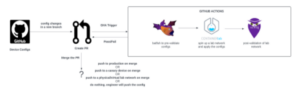CI/CD is crucial in software development to ensure that the code is secure and well tested and it also helps with automated deployment. But, it has become very popular in the networking field as well in the last few years. Once the industry realized the importance of versioning of configs, all the network configuration were templatized and stored in GitHub. As the configs were in version controlled systems like GitHub, we can leverage the power of CI/CD to have automated testing and deployment.
The Case for CI/CD in Networking
Validation of Network Configurations
Traditional network configuration methods have been manually intensive and error-prone. By integrating CI into your workflow, you can simulate network changes in a controlled environment, catching syntax errors and misconfigurations before they affect live systems. Automated tests can be run to predict whether a configuration change might disrupt connectivity or compromise network stability. This pre-deployment validation is critical in ensuring that new configurations will not inadvertently cause outages.
Security Compliance and Risk Mitigation
Security is paramount when managing network configurations. A CI pipeline can automatically scan configurations for sensitive information—such as hard-coded passwords or improperly secured certificates—and ensure compliance with established security standards. By integrating external vulnerability scanning tools, engineers can identify potential CVEs and enforce benchmarks based on frameworks like NIST and CIS. This proactive approach reduces the risk of deploying configurations that might expose the network to security threats.
Streamlined Deployment with CD
Once configurations have been validated through CI, the CD process takes over. With CD, changes are automatically rolled out to production devices using strategies like phased rollouts, canary deployments, or full production deployments. This automation ensures that once a configuration has been approved, it can be deployed quickly and safely, reducing manual intervention and minimizing the risk of human error during deployment.
Implementing validation of network configurations
Validating network configuration changes is cumbersome and error prone. With CI, you can validate various aspects of the configurations that will be discussed with an example.
Following is the simple CI pipeline to validate network configurations using open source tools.

All the configurations are stored in GitHub. When the network engineer creates a new PR with its changes, it will trigger GitHub CI pipeline actions to validate the configs using Batfish, Containerlab and SuzieQ.
Let’s go through each component of the CI pipeline to understand its purpose.
Key Components of the CI Pipeline
Batfish: Simulating Network Behavior
Batfish is an open-source network configuration analysis tool that builds a vendor-neutral model of your network using the submitted configurations. This simulation allows you to test various scenarios such as:
- Reachability Checks: Confirming that devices can successfully communicate with one another.
- Policy Enforcement: Ensuring that security policies are correctly applied across the network.
- Access Control Validation: Detecting whether access lists are properly defined and enforced.
- BGP and Interface Status: Predicting whether routing sessions and interfaces will be operational after applying the new configurations.
The primary benefit of using Batfish is its ability to catch potential issues before they reach production. By simulating network behavior, Batfish helps reduce downtime, improve network security, and accelerate change management processes. However, it is important to note that Batfish may not capture every possible failure scenario, particularly those related to hardware-specific issues.
Containerlab: Crafting Digital Twins of Your Network
Containerlab is an open-source framework designed for managing container-based network labs. It supports multiple network vendors and enables engineers to design and test both simple and complex network topologies. Using a YAML file, you can define your network’s topology and version control it alongside your configurations. Containerlab’s digital twin allows you to:
- Simulate Network Topologies: Replicate the network environment in a controlled lab setting.
- Test Configuration Changes: Apply new configurations to see how they impact network performance.
- Develop Network Automation: Experiment with automation scripts and deployment strategies in a risk-free environment.
While Containerlab provides an excellent simulation of network software behavior, it does not fully replicate the hardware characteristics of actual network devices. Despite this limitation, it remains an invaluable tool for pre-deployment testing and educational purposes.
SuzieQ: Observing Network State and Performance
SuzieQ is an open-source network observability platform that continuously collects state data from network devices across various vendors. Its ability to gather historical data and provide real-time insights makes it an excellent complement to CI/CD pipelines. SuzieQ’s features include:
- Data Collection and Analysis: Aggregating metrics and state information from the network to track performance over time.
- Historical Trending: Analyzing past data to identify potential configuration issues.
- Real-Time Validation: Ensuring that critical components like BGP sessions and interfaces remain operational after configuration changes.
By integrating SuzieQ into the CI pipeline, network engineers can validate that the simulated changes in the lab environment will produce the desired outcomes in production. This dual-layer validation—first through simulation and then through observability—provides a robust safety net for network operations.
Addressing Challenges and Limitations
While CI/CD pipelines offer significant benefits for network configuration management, there are inherent challenges:
- Hardware-Specific Issues: Tools like Batfish and Containerlab excel at simulating network behavior but may not capture hardware-specific bugs or failures. It is essential to complement automated testing with periodic real-world tests.
- Complexity of Network Environments: Modern networks are dynamic and complex. Automated pipelines must be continuously updated to reflect changes in topology, device firmware, and network protocols.
- Initial Setup and Maintenance: Establishing a CI/CD pipeline requires an upfront investment in time and resources. Continuous maintenance is required to ensure that the pipeline remains effective as the network evolves.
By acknowledging these challenges, organizations can better plan for incremental improvements and gradually introduce more sophisticated testing scenarios into their CI/CD pipelines.
Future Trends in Network Automation
As networks continue to evolve, the integration of CI/CD pipelines with advanced technologies like artificial intelligence and machine learning is on the horizon. Predictive analytics may soon
allow network engineers to foresee potential issues before they arise, further reducing downtime and increasing the reliability of network operations. Moreover, as network environments become increasingly software-driven, the role of automation will only grow more critical, leading to even tighter integration between network configuration management and automated testing tools.
In summary, adopting CI/CD pipelines for network configuration validation represents a transformative approach in network management. By applying software engineering principles, network teams can achieve faster turnaround times, improved security, and a more reliable network infrastructure. Automated tools such as Batfish, Containerlab, and SuzieQ play a pivotal role in simulating and validating network changes, allowing engineers to catch errors and potential outages before they impact production.
While no testing strategy can capture every possible failure mode, a well-designed CI/CD pipeline significantly reduces risk and accelerates deployment processes. As networks grow more complex and demands for uptime intensify, embracing CI/CD for network configuration management is not just an innovation—it’s a necessity for modern IT operations. This agile, automated approach not only ensures the safe rollout of new configurations but also fosters a culture of continuous improvement and proactive risk management within the network engineering community.








